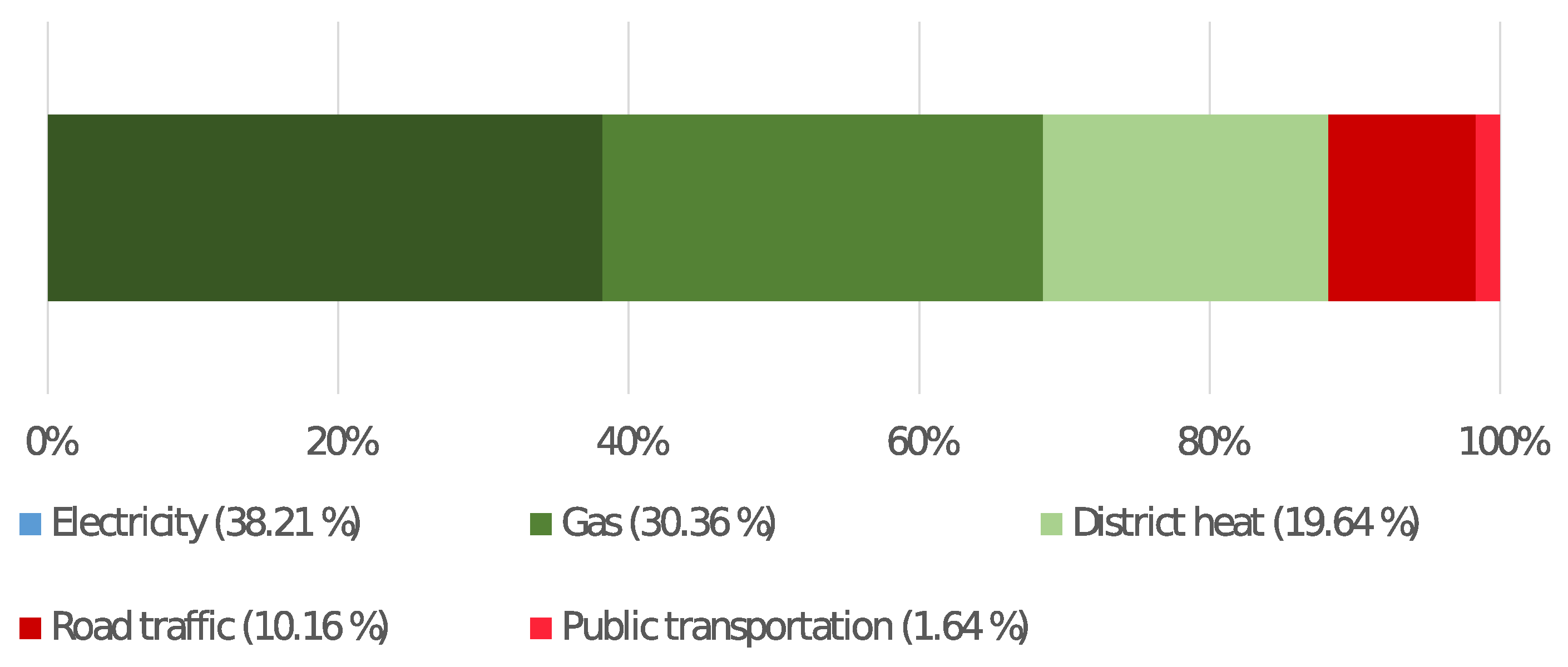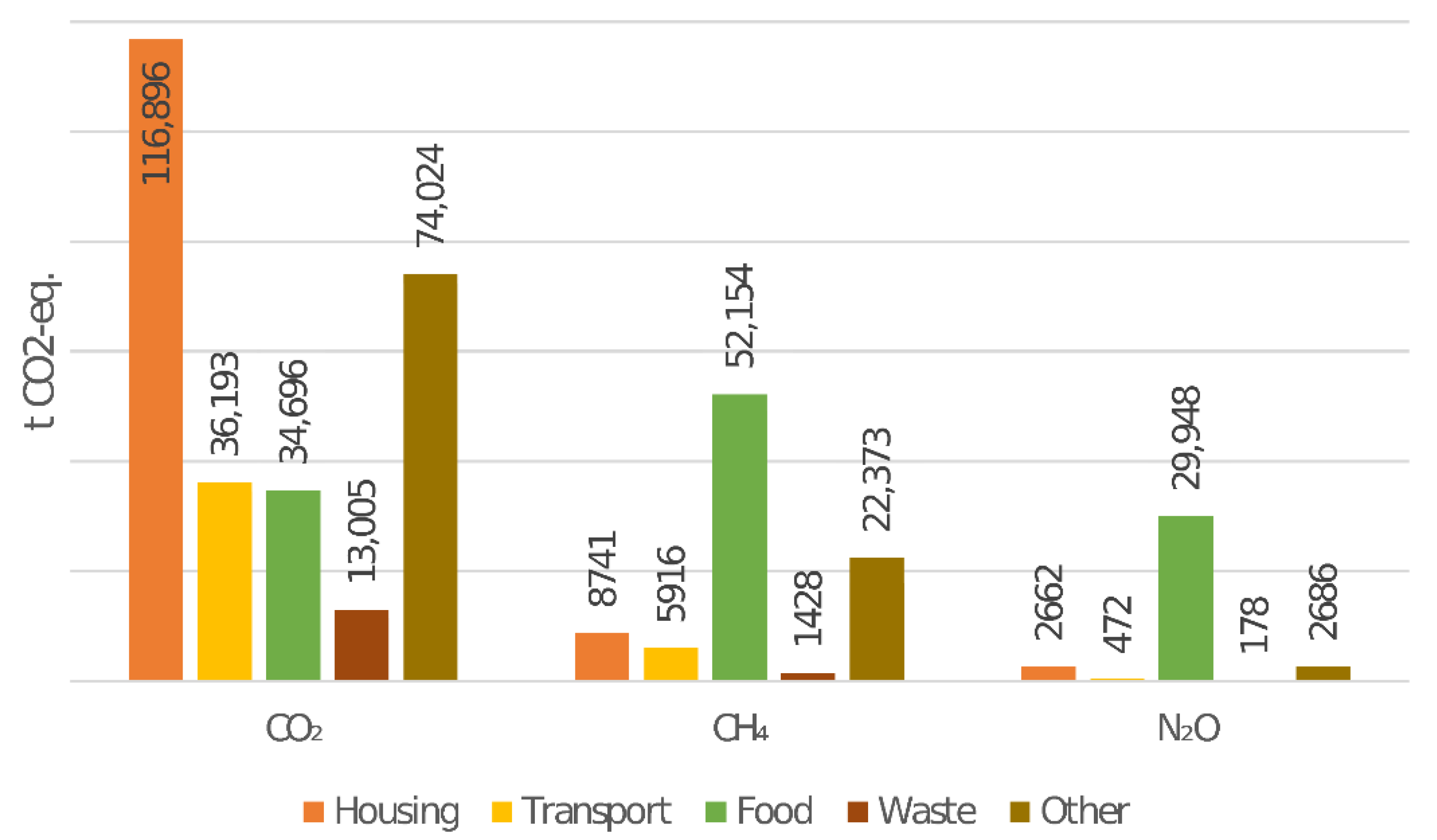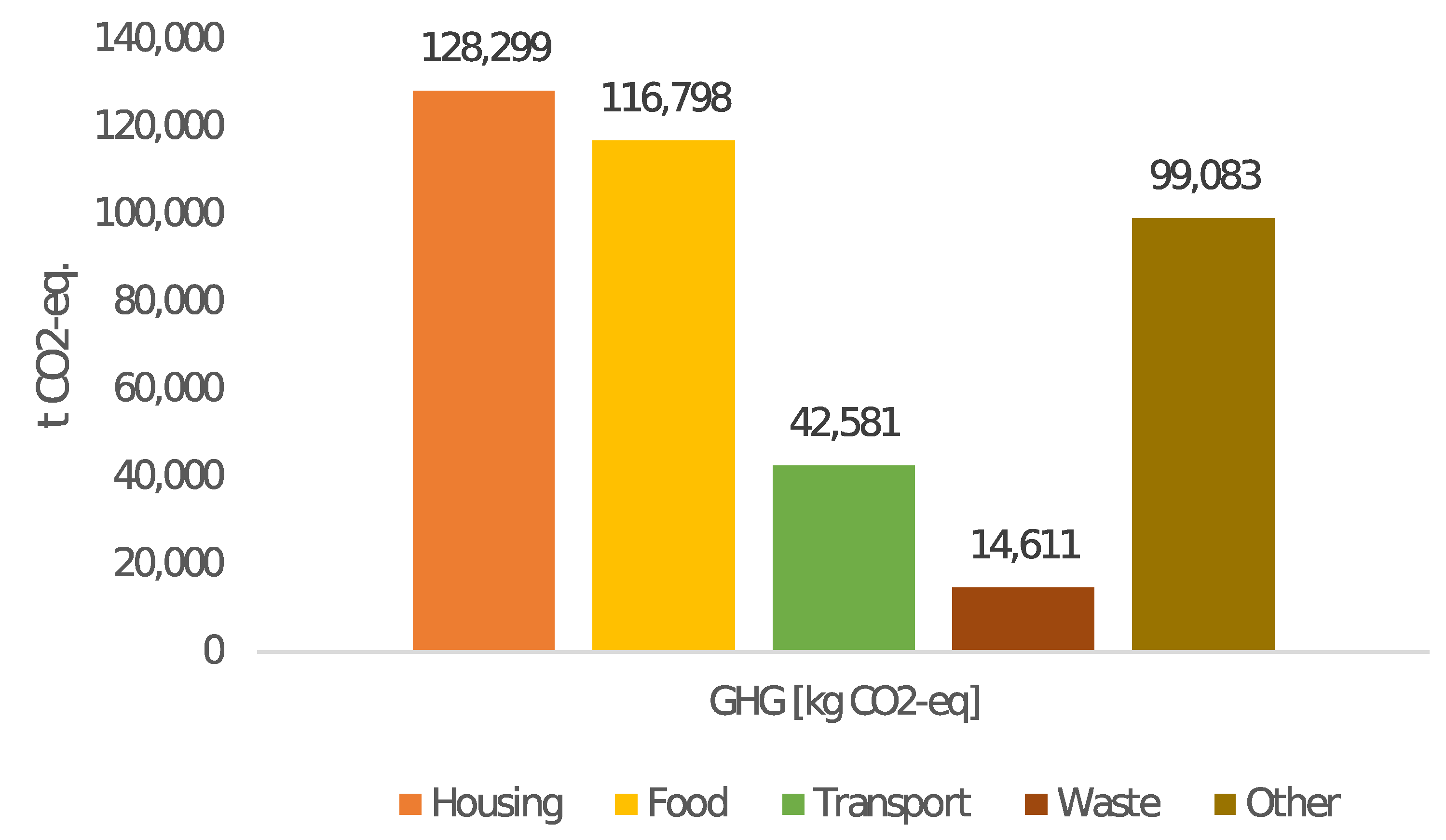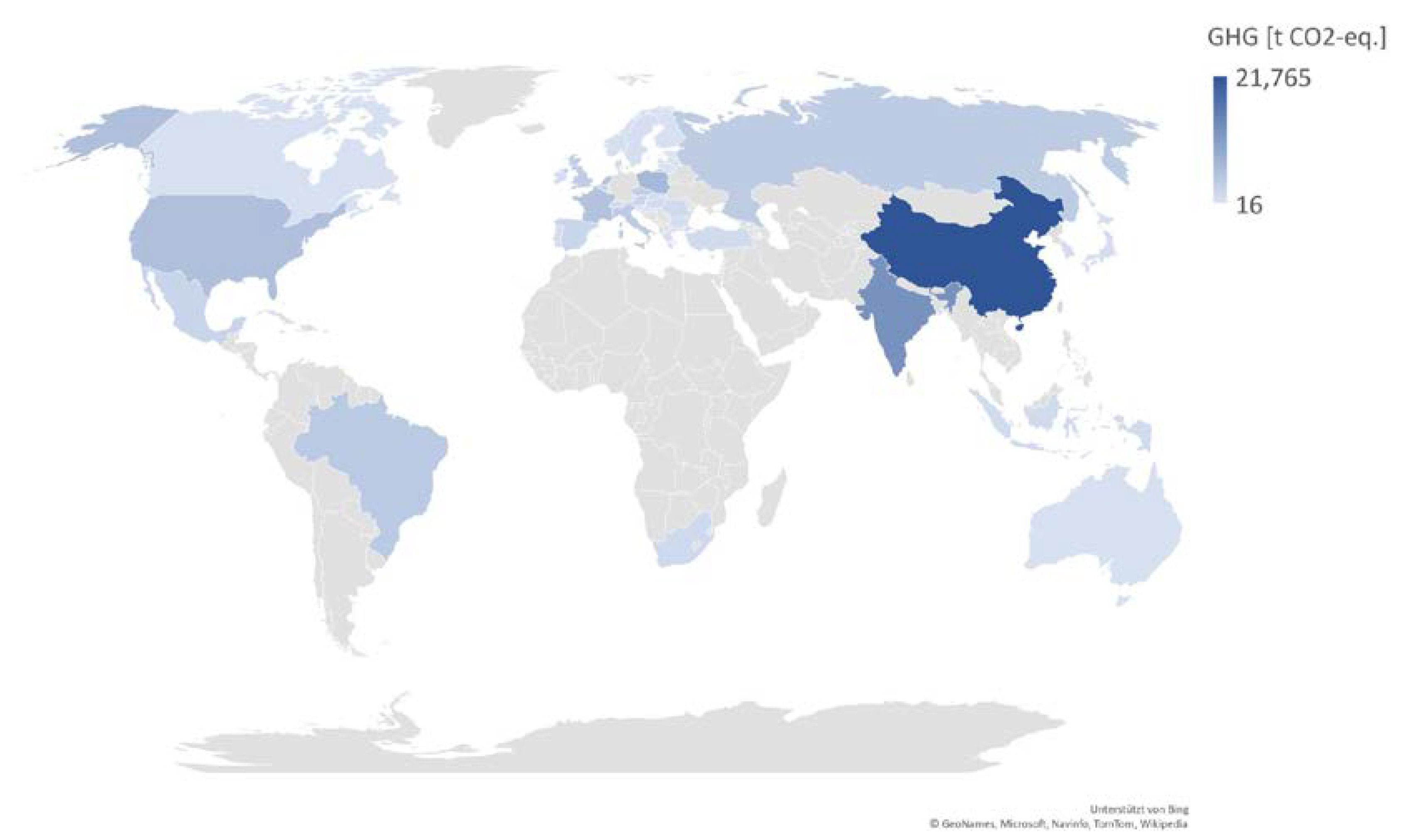Territorial-Based vs. Consumption-Based Carbon Footprint of an Urban District—A Case Study of Berlin-Wedding
Abstract
:1. Introduction
- Scope 1: GHG emissions from sources located within the city boundary;
- Scope 2: GHG emissions occurring as a consequence of the use of grid-supplied electricity, heat, steam and/or cooling within the city boundary;
- Scope 3: All other GHG emissions that occur outside the city boundary as a result of activities taking place within the city boundary.
2. Materials and Methods
2.1. Territorial-Based Carbon Accounting
2.2. Consumption-Based Carbon Accounting
2.3. Comparison
3. Results
3.1. Territorial-Based Carbon Accounting
3.2. Consumption-Based Carbon Accounting
3.3. Comparison of the Approaches
4. Discussion
4.1. Discussion of Application of Methods and Used Data Sources
4.2. Discussion of Limitations of Case Study Results
5. Conclusions
Supplementary Materials
Author Contributions
Funding
Institutional Review Board Statement
Informed Consent Statement
Data Availability Statement
Conflicts of Interest
References
- United Nations Development Programme Goal 11: Sustainable Cities and Communities. Available online: https://www.undp.org/content/undp/en/home/sustainable-development-goals/goal-11-sustainable-cities-and-communities.html (accessed on 28 September 2020).
- Grimm, N.B.; Faeth, S.H.; Golubiewski, N.E.; Redman, C.L.; Wu, J.; Bai, X.; Briggs, J.M. Global change and the ecology of cities. Science 2008, 319, 756–760. [Google Scholar] [CrossRef] [PubMed] [Green Version]
- Rosenzweig, C.; Solecki, W.; Hammer, S.A.; Mehrotra, S. Cities lead the way in climate–change action. Nature 2010, 467, 909–911. [Google Scholar] [CrossRef] [PubMed]
- British Standards Institution. PAS 2070 specification for the assessment of greenhouse gas emissions of a city. In Direct Plus Supply Chain and Consumption-Based Methodologies; BSI Standards Limited: London, UK, 2013; ISBN 978-0-580-77402-7. [Google Scholar]
- WRI. C40—ICLEI Global Protocol for Community-Scale Greenhouse Gas Emission Inventories. An Accounting and Reporting Standard for Cities; WRI: Washington, DC, USA, 2014; ISBN 1-56973-846-7. [Google Scholar]
- IPCC. 2006 IPCC Guidelines for National Greenhouse Gas Inventories Volume 1 General Guidance and Reporting; IPCC: Geneva, Switzerland, 2006. [Google Scholar]
- Chen, G.; Shan, Y.; Hu, Y.; Tong, K.; Wiedmann, T.; Ramaswami, A.; Guan, D.; Shi, L.; Wang, Y. Review on City-Level Carbon Accounting. Environ. Sci. Technol. 2019, 53, 5545–5558. [Google Scholar] [CrossRef] [PubMed]
- Lombardi, M.; Laiola, E.; Tricase, C.; Rana, R. Assessing the Urban Carbon Footprint: An Overview. Environ. Impact Assess. Rev. 2017, 66, 43–52. [Google Scholar] [CrossRef]
- WBCSD. WRI The Greenhouse Gas Protocol—A Corporate Accounting and Reporting Standard (Revised Edition); WBCSD: Geneva, Switzerland, 2004; p. 116. [Google Scholar]
- Chen, S.; Long, H.; Chen, B.; Feng, K.; Hubacek, K. Urban Carbon Footprints across Scale: Important Considerations for Choosing System Boundaries. Appl. Energy 2020, 259, 114201. [Google Scholar] [CrossRef]
- Arioli, M.S.; D’Agosto, M.A.; Amaral, F.G.; Cybis, H.B.B. The evolution of city-scale GHG emissions inventory methods: A systematic review. Environ. Impact Assess. Rev. 2020, 80, 106316. [Google Scholar] [CrossRef]
- Athanassiadis, A.; Christis, M.; Bouillard, P.; Vercalsteren, A.; Crawford, R.H.; Khan, A.Z. Comparing a territorial-based and a consumption-based approach to assess the local and global environmental performance of cities. J. Clean. Prod. 2018, 173, 112–123. [Google Scholar] [CrossRef]
- Fan, J.-L.; Hou, Y.-B.; Wang, Q.; Wang, C.; Wei, Y.-M. Exploring the characteristics of production-based and consumption-based carbon emissions of major economies: A multiple-dimension comparison. Appl. Energy 2016, 184, 790–799. [Google Scholar] [CrossRef]
- Bastianoni, S.; Pulselli, F.M.; Tiezzi, E. The problem of assigning responsibility for greenhouse gas emissions. Ecol. Econ. 2004, 49, 253–257. [Google Scholar] [CrossRef]
- Boitier, B. CO2 Emissions Production-Based Accounting vs Consumption: Insights from the WIOD Databases. 2012. Available online: http://www.wiod.org/conferences/groningen/paper_Boitier.pdf (accessed on 28 June 2021).
- Li, Y.; Hewitt, C.N. The Effect of Trade between China and the UK on National and Global Carbon Dioxide Emissions. Energy Policy 2008, 36, 1907–1914. [Google Scholar] [CrossRef]
- Peters, G.P. From production-based to consumption-based national emission inventories. Ecol. Econ. 2008, 65, 13–23. [Google Scholar] [CrossRef]
- Peters, G.P.; Hertwich, E.G. Post-kyoto greenhouse gas inventories: Production versus consumption. Clim. Chang. 2008, 86, 51–66. [Google Scholar] [CrossRef]
- Zhang, Q.; Fang, K. Comment on “Consumption-Based versus Production-Based Accounting of CO2 Emissions: Is There Evidence for Carbon Leakage?”. Environ. Sci. Policy 2019, 101, 94–96. [Google Scholar] [CrossRef]
- Caro, D.; Bastianoni, S.; Borghesi, S.; Pulselli, F.M. On the Feasibility of a Consumer-Based Allocation Method in National GHG Inventories. Ecol. Indic. 2014, 36, 640–643. [Google Scholar] [CrossRef]
- Wang, X.; Zheng, H.; Wang, Z.; Shan, Y.; Meng, J.; Liang, X.; Feng, K.; Guan, D. Kazakhstan’s CO2 Emissions in the Post-Kyoto Protocol Era: Production- and Consumption-Based Analysis. J. Environ. Manag. 2019, 249, 109393. [Google Scholar] [CrossRef] [Green Version]
- Harris, S.; Weinzettel, J.; Bigano, A.; Källmén, A. Low Carbon Cities in 2050? GHG Emissions of European Cities Using Production-Based and Consumption-Based Emission Accounting Methods. J. Clean. Prod. 2019, 119206. [Google Scholar] [CrossRef]
- Liu, L.; Qu, J.; Maraseni, T.N.; Niu, Y.; Zeng, J.; Zhang, L.; Xu, L. Household CO2 Emissions: Current Status and Future Perspectives. IJERPH 2020, 17, 7077. [Google Scholar] [CrossRef]
- Bakó, F.; Berkes, J.; Szigeti, C. Households’ Electricity Consumption in Hungarian Urban Areas. Energies 2021, 14, 2899. [Google Scholar] [CrossRef]
- Amt für Statistik Berlin-Brandenburg Einwohnerinnen und Einwohner im Land Berlin am 31. December 2018, p. 38. Available online: https://statistik-berlin-brandenburg.de/publikationen/stat_berichte/2019/SB_A01-16-00_2018h02_BE.pdf (accessed on 28 June 2021).
- Land Berlin Wedding. Available online: http://wedding.berndschimmler.de/index.html (accessed on 9 May 2020).
- Hermannsson, K.; McIntyre, S.G. Local Consumption and Territorial Based Accounting for CO2 Emissions. Ecol. Econ. 2014, 104, 1–11. [Google Scholar] [CrossRef] [Green Version]
- Hertle, H.; Dünnebeil, F.; Gebauer, C.; Gugel, B.; Heuer, C.; Kutzner, F.; Vogt, R. Empfehlungen zur Methodik der Kommunalen Treibhausgas- Bilanzierung für den Energie- und Verkehrssektor in Deutschland; Institut für Energie: Leipzig, Germany, 2014; p. 103. [Google Scholar]
- ICLEI HEAT—Harmonized Emissions Analysis Tool. Available online: https://ledsgp.org/wp-content/uploads/2015/09/HEATplus_brochure.pdf (accessed on 6 October 2020).
- ICLEI Clean Air Climate Protection Software. Available online: http://www.4cleanair.org/Oldmembers/members/committee/ozone/webcastSIslides.pdf (accessed on 6 October 2020).
- Hertle, H.; Dünnebeil, F.; Gugel, B.; Rechsteiner, E.; Reinhard, C. Empfehlungen zur Methodik der Kommunalen Treibhausgasbilanzierung für den Energie- und Verkehrssektor in Deutschland Kurzfassung (Aktualisierung 11/2019); ifeu: Heidelberg, Germany, 2019. [Google Scholar]
- Allekotte, M.; Biemann, K.; Heidt, C.; Colson, M.; Knörr, W. Aktualisierung der Modelle TREMOD/TREMOD-MM für die Emissionsberichterstattung 2020 (Berichtsperiode 1990–2018); Umweltbundesamt: Vienna, Austria, 2020; p. 205. [Google Scholar]
- Diekelmann, P. Klimaschutz in Kommunen: Praxisleitfaden; Deutsches Institut für Urbanistik, Institut für Energie- und Umweltforschung, Klima-Bündnis Europäischer Städte mit den Indigenen Völkern der Regenwälder zum Erhalt der Erdatmosphäre, Eds.; Service & Kompetenzzentrum Kommunaler Klimaschutz, SK:KK; 3. aktualisierte und erweiterte Auflage; Deutsches Institut für Urbanistik gGmbH: Berlin, Germany, 2018; ISBN 978-3-88118-585-1. [Google Scholar]
- Senatsverwaltung für Wirtschaft, Energie und Betriebe Energieatlas Berlin. Available online: https://energieatlas.berlin.de/ (accessed on 1 May 2021).
- Senatsverwaltung für Stadtentwicklung und Wohnen Umweltatlas Berlin/Verkehrsmengen. 2014. Available online: https://fbinter.stadt-berlin.de/fb/index.jsp?loginkey=zoomStart&mapId=wmsk_07_01verkmeng2014@senstadt&bbox=372260,5811257,399837,5825075 (accessed on 26 September 2020).
- BVG FahrInfo und Linienverlauf. Available online: https://www.bvg.de/de/Fahrinfo (accessed on 1 May 2021).
- S-Bahn Berlin GmbH Linienfahrpläne. Available online: https://sbahn.berlin/fahren/fahrplanauskunft/linienfahrplaene/ (accessed on 1 May 2021).
- Soltani, M.; Rahmani, O.; Beiranvand Pour, A.; Ghaderpour, Y.; Ngah, I.; Misnan, S.H. Determinants of variation in household energy choice and consumption: Case from Mahabad City, Iran. Sustainability 2019, 11, 4775. [Google Scholar] [CrossRef] [Green Version]
- Afionis, S.; Sakai, M.; Scott, K.; Barrett, J.; Gouldson, A. Consumption-Based Carbon Accounting: Does it have a future?: Consumption-Based Carbon Accounting. WIREs Clim. Chang. 2017, 8, e438. [Google Scholar] [CrossRef]
- Amt für Statistik Berlin-Brandenburg Einkommen Und Einnahmen Sowie Ausgaben Privater Haushalte Im Land Berlin 2018 2020. Available online: https://cdn0.scrvt.com/ee046e2ad31b65165b1780ff8b3b5fb6/8a6de9bad2ecfdb7/a6beefca459a/SB_O02-03-00_2018j05_BE.pdf (accessed on 28 June 2021).
- Stadler, K.; Wood, R.; Bulavskaya, T.; Södersten, C.-J.; Simas, M.; Schmidt, S.; Usubiaga, A.; Acosta-Fernández, J.; Kuenen, J.; Bruckner, M.; et al. EXIOBASE 3: Developing a time series of detailed environmentally extended multi-regional input-output tables: EXIOBASE 3. J. Ind. Ecol. 2018, 22, 502–515. [Google Scholar] [CrossRef] [Green Version]
- Pichler, P.-P.; Zwickel, T.; Chavez, A.; Kretschmer, T.; Seddon, J.; Weisz, H. Reducing urban greenhouse gas footprints. Sci. Rep. 2017, 7, 14659. [Google Scholar] [CrossRef] [Green Version]
- USEPA. Global Greenhouse Gas Emissions Data. Available online: https://www.epa.gov/ghgemissions/global-greenhouse-gas-emissions-data (accessed on 26 September 2020).
- Davis, S.J.; Caldeira, K. Consumption-based accounting of CO2 emissions. Proc. Natl. Acad. Sci. USA 2010, 107, 5687–5692. [Google Scholar] [CrossRef] [Green Version]
- Senatsverwaltung für Stadtentwicklung und Umwelt Schriftliche Anfrage Des Abgeordneten Gerwald Claus-Brunner (PIRATEN)—Aktueller Berliner Motorisierungsgrad 2015. Available online: https://kleineanfragen.de/berlin/17/16873-aktueller-berliner-motorisierungsgrad (accessed on 28 June 2021).
- Engel, E. Die Productions-und Consumtionsverhältnisse des Königreichs Sachsen. In Zeitschrift des Statistischen Bureaus des Königlich Sächsischen Ministerium des Inneren; Forgotten Books: London, UK, 1857. [Google Scholar]
- Bundeszentrale für Politische Bildung Einkommen privater Haushalte|bpb. Available online: https://www.bpb.de/nachschlagen/zahlen-und-fakten/soziale-situation-in-deutschland/61754/einkommen-privater-haushalte (accessed on 21 June 2021).
- Bezirksamt Berlin Mitte Basisdaten Zur Bevölkerung Und Sozialen Lage Im Bezirk Berlin-Mitte 2018. Available online: https://digital.zlb.de/viewer/metadata/15698546/1/ (accessed on 28 June 2021).
- Thöle, G.; Reitemeyer, F. Bezirkliche Treibhausgasbilanz nach BISKO für Charlottenburg-Wilmersdorf. Available online: https://www.berlin.de/ba-charlottenburg-wilmersdorf/verwaltung/aemter/umwelt-und-naturschutzamt/klimaschutz/artikel.712319.php (accessed on 24 September 2020).
- Senatsverwaltung für Stadtentwicklung und Wohnen Geoportal Berlin/Siedlungsstruktur Wohnen—Bezirksregionen 2010. Available online: https://fbinter.stadt-berlin.de/fb/index.jsp?loginkey=zoomStart&mapId=k_siedlungsstruktur_bzr@senstadt&bbox=373148,5812836,400960,5826772 (accessed on 24 September 2020).
- Umweltbundesamt Energieverbrauch für Fossile und Erneuerbare Wärme. Available online: https://www.umweltbundesamt.de/daten/energie/energieverbrauch-fuer-fossile-erneuerbare-waerme (accessed on 24 September 2020).
- Senatsverwaltung für Stadtentwicklung und Wohnen Umweltatlas Berlin/Gebäudealter Der Wohnbebauung. Available online: https://fbinter.stadt-berlin.de/fb/index.jsp (accessed on 24 September 2020).
- Amt für Statistik Berlin-Brandenburg Energie- und CO2-Bilanz in Berlin 2017. 2019, p. 40. Available online: https://www.statistik-berlin-brandenburg.de/publikationen/stat_berichte/2019/SB_E04-04-00_2017j01_BE.pdf (accessed on 28 June 2021).
- Xu, C.; Haase, D.; Su, M.; Yang, Z. The Impact of Urban Compactness on Energy-Related Greenhouse Gas Emissions across EU Member States: Population Density vs Physical Compactness. Appl. Energy 2019, 254, 113671. [Google Scholar] [CrossRef]
- Angel, S.; Arango Franco, S.; Liu, Y.; Blei, A.M. The Shape Compactness of Urban Footprints. Prog. Plan. 2020, 139, 100429. [Google Scholar] [CrossRef]
- Reitemeyer, F. Erstellung Einer Treibhausgasbilanz Für Bezirke Und Vergleich Mit Einer Verbraucherbasierten Treibhausgasbilanz Mit Direkten Und Indirekten Emissionen 2019. Available online: https://www.berlin.de/ba-charlottenburg-wilmersdorf/verwaltung/aemter/umwelt-und-naturschutzamt/artikel.113003.php (accessed on 28 June 2021).
- Ivanova, D.; Vita, G.; Steen-Olsen, K.; Stadler, K.; Melo, P.C.; Wood, R.; Hertwich, E.G. Mapping the Carbon Footprint of EU Regions. Environ. Res. Lett. 2017, 12, 054013. [Google Scholar] [CrossRef]
- Bundesministerium für Umwelt, Naturschutz und nukleare Sicherheit Klimaschutz in Zahlen (2018)—Fakten, Trends und Impulse deutscher Klimapolitik. 2018, p. 72. Available online: https://www.bmu.de/fileadmin/Daten_BMU/Pools/Broschueren/klimaschutz_in_zahlen_2018_bf.pdf (accessed on 28 June 2021).
- Kovács, Z.; Harangozó, G.; Szigeti, C.; Koppány, K.; Kondor, A.C.; Szabó, B. Measuring the Impacts of Suburbanization with Ecological Footprint Calculations. Cities 2020, 101, 102715. [Google Scholar] [CrossRef]
- Senatsverwaltung für Stadtentwicklung und Wohnen Berliner Mietspiegel 2019. Available online: https://www.stadtentwicklung.berlin.de/download/mietspiegel2019/Broschuere_Mietspiegel2019.pdf (accessed on 28 June 2021).
- Cremer, A.; Müller, K.; Berger, M.; Finkbeiner, M. A Framework for Environmental Decision Support in Cities Incorporating Organizational LCA. Int. J. Life Cycle Assess. 2020, 25, 2204–2216. [Google Scholar] [CrossRef]
- Cremer, A.; Berger, M.; Müller, K.; Finkbeiner, M. The First City Organizational LCA Case Study: Feasibility and Lessons Learned from Vienna. Sustainability 2021, 13, 5062. [Google Scholar] [CrossRef]





| Zip Code | Share of Area in Wedding [%] | District Heat Consumption Wedding [GWh] | Natural Gas Consumption Wedding [GWh] | Electricity Consumption Wedding [GWh] |
|---|---|---|---|---|
| 13347 | 86 | 83.9 | 48.4 | 54.6 |
| 13349 | 100 | 23.8 | 49.4 | 31.1 |
| 13351 | 100 | 37.5 | 31.3 | 21.3 |
| 13353 | 100 | 148.7 | 328.2 | 146.6 |
| 13359 | 2 | 0.1 | 2.0 | 0.8 |
| 13405 | 1.8 | 4.3 | 15.2 | 13.8 |
| 13407 | 6 | 1.1 | 16.9 | 7.7 |
| 13409 | 1 | 0.1 | 1.4 | 0.6 |
| Total | 299.4 | 492.8 | 276.5 |
| District Heat | Natural Gas | Electricity | |
|---|---|---|---|
| Energy consumption [GWh] | 299.4 | 492.8 | 276.5 |
| Emission factor [t CO2-eq/MWh] | 0.26 | 0.25 | 0.55 |
| CO2-eq. [t] | 78,741.1 | 121,722.3 | 153,187.3 |
| Vehicle-km per Day (Tkm) | Vehicle-km per Year (Tkm) | Final Energy Consumption (GWh) | CO2-eq. Emissions (t) | |
|---|---|---|---|---|
| Cars | 346 | 126,122 | 99 | 30,328 |
| Trucks > 3.5 t | 13 | 4627 | 13 | 3908 |
| Delivery vans ≤ 3.5 t | 42 | 15,459 | 13 | 3932 |
| Buses | 3 | 1191 | 5 | 1646 |
| Coaches | 1 | 422 | 2 | 541 |
| Motorcycles | 10 | 3741 | 1 | 370 |
| Total | 415 | 151,562 | 132 | 40,724 |
| Seat Kilometers per Year (Tkm) | Energy Consumption (GWh/a) | CO2-eq (t/a) | |
|---|---|---|---|
| Urban Railway | 82,047 | 1.66 | 998 |
| Metro 6 | 299,065 | 6.06 | 3637 |
| Metro 9 | 137,014 | 2.78 | 1666 |
| Tram M13 | 14,367 | 0.29 | 175 |
| Tram 50 | 7855 | 0.16 | 96 |
| Total | 540,348 | 10.95 | 6572 |
| CO2 (t CO2-eq.) | CH4 (t CO2-eq.) | N2O (t CO2-eq.) | |||||||||
|---|---|---|---|---|---|---|---|---|---|---|---|
| Sector | CO2 | Total GHG | Share (%) | Sector | CH4 | Total GHG | Share (%) | Sector | N2O | Total GHG | Share (%) |
| Real estate services | 31,583 | 33,960 | 93 | Animal products | 14,723 | 23,126 | 64 | Wheat | 5749 | 8387 | 69 |
| Steam and hot water supply services | 22,116 | 22,605 | 98 | Crops | 11,002 | 18,051 | 61 | Cereal grains | 5030 | 7421 | 68 |
| Electricity by coal | 18,243 | 18,924 | 96 | Leather and leather products | 7678 | 12,717 | 60 | Animal products | 4834 | 23,126 | 21 |
| Chemicals | 10,329 | 12,971 | 80 | Products of meat cattle | 6065 | 9149 | 66 | Crops | 3387 | 18,051 | 19 |
| Hotel and restaurant services | 8882 | 12,237 | 73 | Processed rice | 4136 | 6931 | 60 | Products of meat cattle | 2091 | 9149 | 23 |
| Ceramic goods | 8528 | 9595 | 89 | Meat animals | 4115 | 6150 | 67 | Meat animals | 1352 | 6150 | 22 |
| Rubber and plastic products | 6827 | 7505 | 91 | Other Bituminous Coal | 3804 | 7995 | 48 | Hotel and restaurant services | 1027 | 12,237 | 8 |
| Other transport equipment | 5098 | 5776 | 88 | Dairy products | 3591 | 7237 | 50 | Vegetables, fruit, nuts | 979 | 4886 | 20 |
| Motor vehicles, trailers, and semi-trailers | 5011 | 5610 | 89 | Raw milk | 3033 | 4201 | 72 | Leather and leather products | 970 | 12,717 | 8 |
| Textiles | 4722 | 6027 | 78 | Hotel and restaurant services | 2328 | 12,237 | 19 | Dairy products | 946 | 7237 | 13 |
| Rest | 153473 | 266161 | 58 | Rest | 30,136 | 293,577 | 10 | Rest | 9581 | 292,010 | 3 |
| Total | 274,814 | 401,371 | Total | 90,611 | 401,371 | Total | 35,946 | 401,371 | |||
| Territorial-Based Approach | Consumption-Based Approach | |||
|---|---|---|---|---|
| Weaknesses | Strengths | Weaknesses | Strengths | |
| Applicability | Local data for energy consumption and traffic needed | Simple calculations with emission factors | Consumption expenditure data necessary; some advanced mathematics needed | Differentiation of CO2, CH4, N2O |
| Availability of data | Data from different years | Specific data available for Wedding | No local data available | Global IO data with emission factors |
| Reproducibility | Calculation tool is not open source; several standards | Reproduction was possible based on publication by Hertele et al. [28] | No standardization of calculation | |
| Relevance of results | Only final energy consumption is considered | Data is available on site; therefore, results can lead to action in Wedding by local government | Relevance equivalent to resolution of CES data | Results focus on people’s consumption and might change consumption patterns |
| Publication | Emissions per Capita (t-CO2-eq) | Geographical Focus | Supposed Reason for Difference in Result | Consumption- or Territorial-Based |
|---|---|---|---|---|
| This study | 4.61 | Wedding | / | Territorial |
| This study | 4.62 | Wedding | / | Consumption |
| [56] | 7.07 | Charlottenburg Wilmersdorf | Different urban form | Territorial |
| [42] | 8.9 | Berlin | Different databases, lower income of people in Wedding, and larger household sizes | Consumption |
| [57] | 13.7 | Berlin | Different databases, lower income of people in Wedding, and larger household sizes | Consumption |
| [58] | 11.63 | Germany | Lower income in Wedding, less densely populated, lower heating demand in all of Germany because of better energetic renovation rate | Territorial |
Publisher’s Note: MDPI stays neutral with regard to jurisdictional claims in published maps and institutional affiliations. |
© 2021 by the authors. Licensee MDPI, Basel, Switzerland. This article is an open access article distributed under the terms and conditions of the Creative Commons Attribution (CC BY) license (https://creativecommons.org/licenses/by/4.0/).
Share and Cite
Lenk, C.; Arendt, R.; Bach, V.; Finkbeiner, M. Territorial-Based vs. Consumption-Based Carbon Footprint of an Urban District—A Case Study of Berlin-Wedding. Sustainability 2021, 13, 7262. https://doi.org/10.3390/su13137262
Lenk C, Arendt R, Bach V, Finkbeiner M. Territorial-Based vs. Consumption-Based Carbon Footprint of an Urban District—A Case Study of Berlin-Wedding. Sustainability. 2021; 13(13):7262. https://doi.org/10.3390/su13137262
Chicago/Turabian StyleLenk, Clara, Rosalie Arendt, Vanessa Bach, and Matthias Finkbeiner. 2021. "Territorial-Based vs. Consumption-Based Carbon Footprint of an Urban District—A Case Study of Berlin-Wedding" Sustainability 13, no. 13: 7262. https://doi.org/10.3390/su13137262
APA StyleLenk, C., Arendt, R., Bach, V., & Finkbeiner, M. (2021). Territorial-Based vs. Consumption-Based Carbon Footprint of an Urban District—A Case Study of Berlin-Wedding. Sustainability, 13(13), 7262. https://doi.org/10.3390/su13137262








